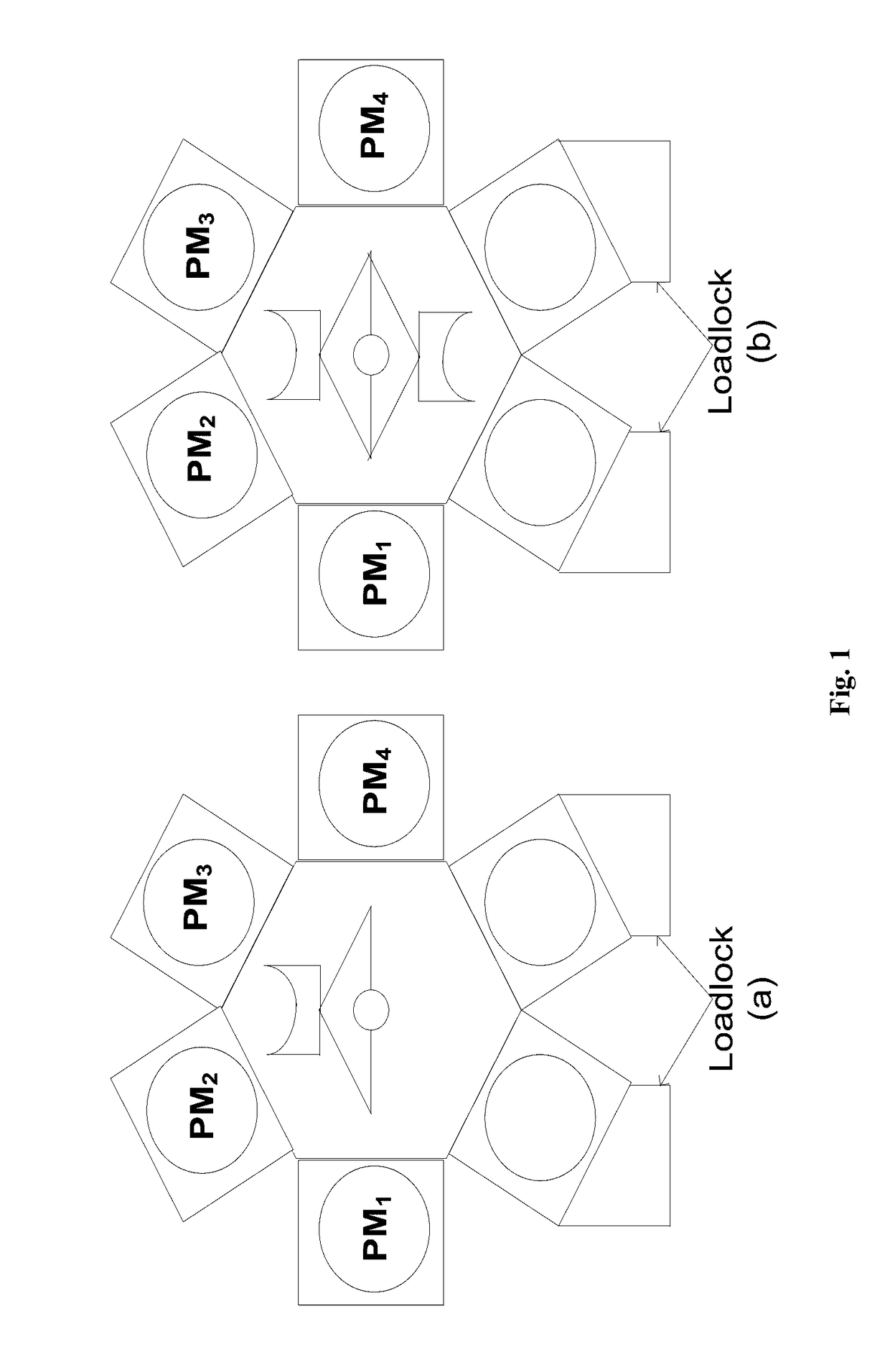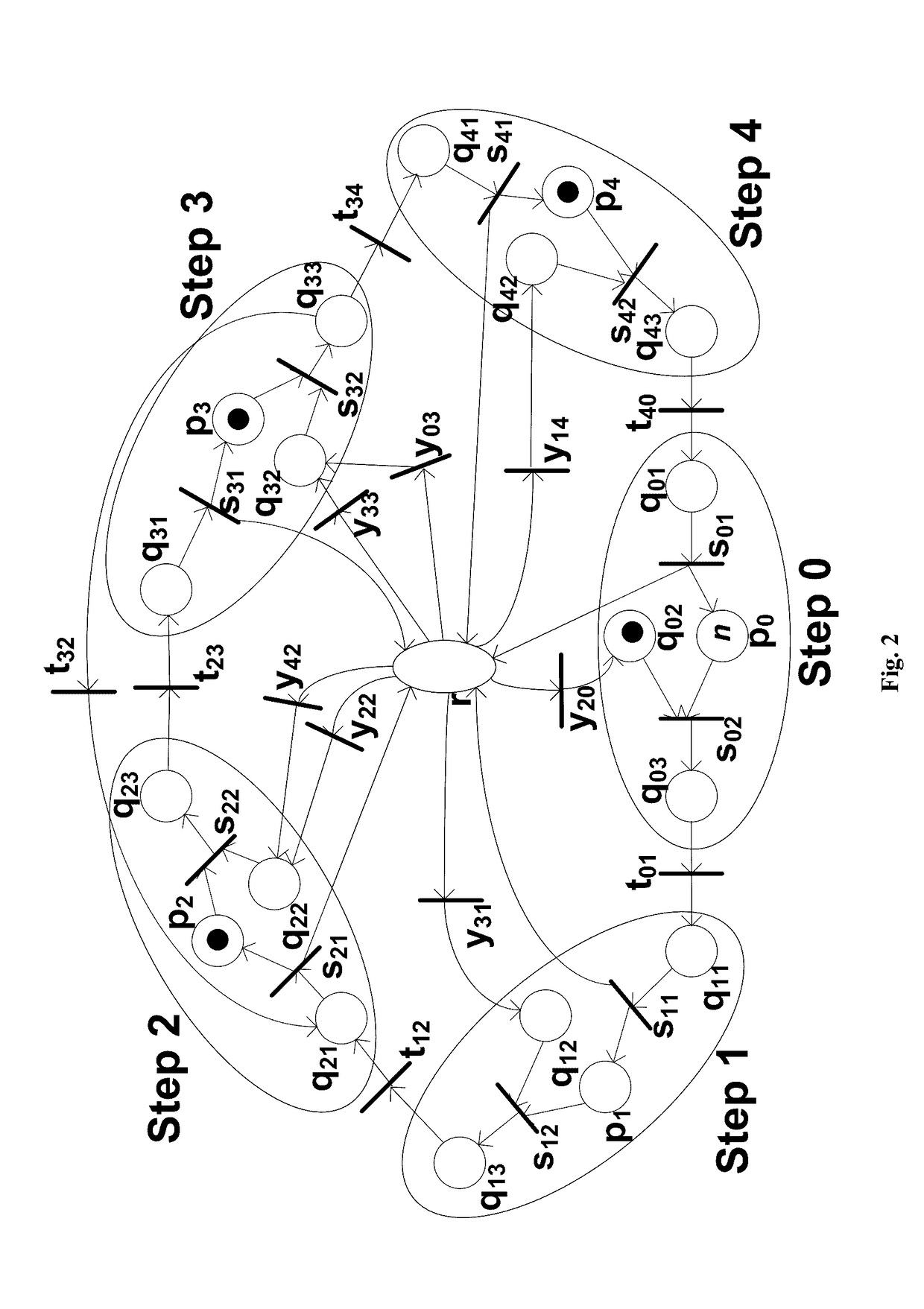Petri Net-based Scheduling of Time Constrained Single-arm Cluster Tools with Wafer Revisiting
a cluster tool and single-arm technology, applied in the field of petri net-based scheduling of time-constrained can solve the problems of difficult scheduling of such a tool to satisfy wafer residency time constraints, difficult scheduling of single-arm cluster tools with wafer revisiting and residency time constraints, etc., and achieve the effect of optimal scheduling and very efficient scheduling
- Summary
- Abstract
- Description
- Claims
- Application Information
AI Technical Summary
Benefits of technology
Problems solved by technology
Method used
Image
Examples
example 1
[0145]The wafer processing time at PM1-4 is α1=120 s, α2=40 s, α3=45 s, and α4=125 s, respectively. After a wafer is completed, it can stay in PM1-4 for at most δ1=30 s, δ2=20 s, δ3=20 s, and δ4=30 s, respectively. The robot task time is λ=μ=3 s.
[0146]For this example, one has π1L=141 s, π1U=171 s, π2L=164 s, π2U=184 s, π3L=169 s, π3U=189 s, π4L=146 s, π1U=176 s, πLmax=169 s, and ƒ1=163 s. One can check that [π1L, π1U]∩[π2L, π2U]∩[π3L, π3U]∩[π4L, π4U]≠Ø and η1≦πLmax. Then, according to Lemma 2, one sets ω0=ω1=ω2=ω3=0 and ω4=πLmax−η1=6 s and a feasible schedule is obtained with cycle time θ=η=πLmax=169 s.
example 2
[0147]The wafer processing time at PM1-4 is α1=95 s, α2=35 s, α3=30 s, and α4=100 s, respectively. After a wafer is completed, it can stay in PM1-4 for at most δ1=30 s, δ2=20 s, δ3=20 s, and δ4=30 s respectively. The robot task time is λ=μ=3 s.
[0148]One has π1L=116 s, π1U=146 s, π2L=139 s, π2U=159 s, π3L=134 s, π3U=154 s, π4L=121 s, π4U=151 s, πLmax=139 s, and η1=143 s. Thus, [π1L, π1U]∩[π2L, π2U]∩[π3L, π3U]∩[π4L, π4U]#Ø and πLmax≦η1≦πUmin hold, and it is schedulable. Then, according to the algorithm given in Lemma 3, one sets ω0=ω1=ω2=ω3=ω4=0 s and a feasible schedule is obtained with cycle time θ=η=η1=143 s.
example 3
[0149]The wafer processing time at PM1-4 is α1=115 s, α2=40 s, α3=45 s, and α4=125 s, respectively. After a wafer is completed, it can stay at PM1-4 for at most δ1=30 s, δ2=20 s, δ3=20 s, and δ4=30 s, respectively. The robot task time is λ=μ=3 s.
[0150]For this example, one has π1L=136 s, π1U=166 s, π2L=164 s, π2U=184 s, π3L=169 s, π3U=189 s, π4L=146 s, π4U=176 s, πLmax=169 s, and η1=163 s. It can be checked that [π1L, π1U]∩[π2L, π2U]∩[π3L, π3U]∩[π4L]=Ø and E={1}. According to Lemma 4, one sets ω0=3, ω1=ω2=ω3=0, and ω4=3. Since ω4>0, the system is schedulable and the obtained schedule is feasible with cycle time θ=η=πLmax=169 s. Based on the PN model, one shows how this schedule is implemented as follows. According to the system modeling, one has M0=({null}, {V3(1)}, {V2(2)}, {V1(1)}) and one assumes the starting time is γ0=0. Then, the system evolves as follows.
[0151]1) From γ0=0 to γ1=15, task sequence 20→robot waits in q02→s02→t01→s11> such that M1=({W1(1)}, {W0(1)}, {W0(2)}, {W0(...
PUM
 Login to View More
Login to View More Abstract
Description
Claims
Application Information
 Login to View More
Login to View More - R&D
- Intellectual Property
- Life Sciences
- Materials
- Tech Scout
- Unparalleled Data Quality
- Higher Quality Content
- 60% Fewer Hallucinations
Browse by: Latest US Patents, China's latest patents, Technical Efficacy Thesaurus, Application Domain, Technology Topic, Popular Technical Reports.
© 2025 PatSnap. All rights reserved.Legal|Privacy policy|Modern Slavery Act Transparency Statement|Sitemap|About US| Contact US: help@patsnap.com



